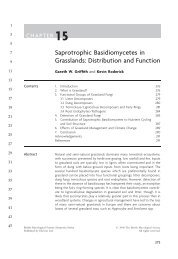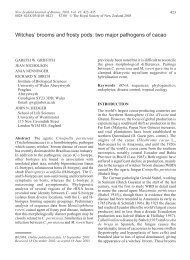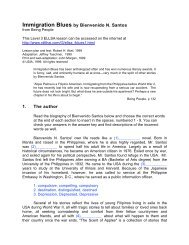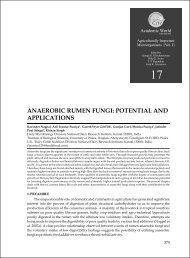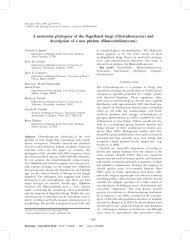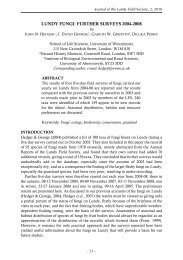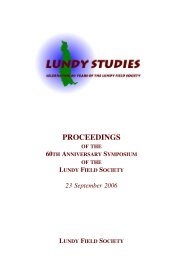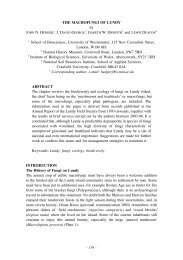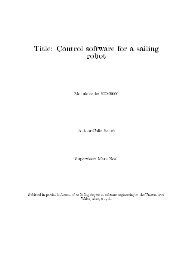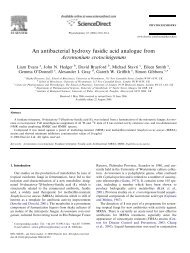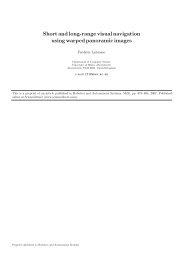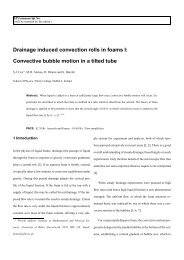Joseph Webb - Users Site - Aberystwyth University
Joseph Webb - Users Site - Aberystwyth University
Joseph Webb - Users Site - Aberystwyth University
Create successful ePaper yourself
Turn your PDF publications into a flip-book with our unique Google optimized e-Paper software.
<strong>Joseph</strong> <strong>Webb</strong><br />
the lights that flit across my brain
<strong>Joseph</strong> <strong>Webb</strong><br />
1908-1962<br />
the lights that flit across my brain<br />
Robert Meyrick<br />
A Retrospective Touring Exhibition of Prints, Drawings and Paintings<br />
first shown at<br />
<strong>Aberystwyth</strong> <strong>University</strong>, School of Art Gallery and Museum<br />
& National Library of Wales, <strong>Aberystwyth</strong><br />
Summer 2007
Acknowledgements<br />
The prints and drawings in this exhibition are from the School of Art Collection at<br />
<strong>Aberystwyth</strong> <strong>University</strong>: twelve were purchased from the artist and London exhibitions between<br />
1931 and 1933. The remainder was among 43 works acquired in 2005 from the artist’s estate<br />
with the support of the V&A/MLA Purchase Grant Fund and the Art Fund. The oil paintings<br />
are on loan from a private collection in Monmouthshire and the four rare impressions of<br />
<strong>Webb</strong>’s ‘mystical’ prints have been deposited on loan to the School of Art by the artist’s estate.<br />
The author would like to thank Beryl Gascoigne and Jane Furst for generously giving their<br />
knowledge, encouragement and friendship, and without whom this exhibition could not<br />
have been possible; Stuart Southall for inspiring the confidence and will to continue against<br />
mounting obligations elsewhere; Hilary and Helena Gerrish for their patience and hospitality,<br />
and the loan of additional works to the exhibition; the V&A/MLA Purchase Grant Fund<br />
and the Art Fund for their continued support; Neil Holland, Phil Garratt, Barry Charlton<br />
and Antoinette McKane of the School of Art for their assistance in mounting the exhibition;<br />
Michael Nobbs for the catalogue design; and Harry Heuser for his valued comments, proof<br />
reading and copy editing of the manuscript.<br />
Colphon<br />
Cover: Asylum, etching, 1930-31<br />
Endpapers: Wallpaper design by <strong>Joseph</strong> <strong>Webb</strong>, undated<br />
Half Title: <strong>Joseph</strong> <strong>Webb</strong><br />
Opposite Page: Doors of the Heart, oil, undated<br />
Opposite Title Page: An Astrologer Instructing his Pupils (detail), drypoint, 1932<br />
Catalogue Design: Michael Nobbs and Neil Holland<br />
Photography: Andrew Baldwin and Neil Holland<br />
Print: Y Lolfa<br />
© Robert Meyrick<br />
School of Art Gallery and Museum | National Library of Wales<br />
<strong>Aberystwyth</strong> 2007<br />
ISBN 978 1 899095 26 1
The measure of a man is not what he has done, important<br />
though that may be an indication; the true measure of a<br />
man’s capacity is what he longs to do.<br />
<strong>Joseph</strong> <strong>Webb</strong>, ‘A Note to Artists’, 17 February 1958
6<br />
1 Hospitalfield Farm etching, 1927 (185 x 285 mm) <strong>Aberystwyth</strong> <strong>University</strong>
‘Thee, Chauntress, oft the woods among’<br />
Landscape and Architectural Etchings, 192 -194<br />
AT AN EARLY AGE, <strong>Joseph</strong> <strong>Webb</strong> was<br />
acclaimed a ‘master etcher’; his ecclesiasticallooking<br />
structures Rat Barn, widely<br />
considered to be his masterpiece, and the<br />
iconic Dream Barn, were etched when he was<br />
just twenty years old. By 1932, the British<br />
Museum and Victoria and Albert Museum<br />
had each acquired five of his prints. Soon<br />
he was exhibiting in London, Chicago, New<br />
York and the Paris Salon. In 1933, aged 25,<br />
he staged his first solo exhibition at P. &<br />
D. Colnaghi in Old Bond Street, the most<br />
prestigious of the London print dealers and<br />
publishers. Its Director Harold Wright was a<br />
keen advocate of <strong>Webb</strong>’s work and, not long<br />
afterwards, they collaborated to compile a<br />
catalogue raisonné of his prints. Yet despite<br />
this early promise and his absolute faith in<br />
his worth as an artist, <strong>Webb</strong> was unable to<br />
sustain his reputation and career. After 1933<br />
he made prints only sporadically, finally<br />
giving up etching in 1947. Subsequently, he<br />
helped his common-law wife manage a café<br />
in Reading and, during the last six years<br />
of his life, ran a boarding house in South<br />
Kensington; few who encountered him would<br />
have realised that he was an artist.<br />
<strong>Webb</strong> was born in Ealing in 1908, the son<br />
of a market gardener. He studied painting at<br />
Ealing School of Art (1920-22) and in 1925<br />
was awarded a scholarship to the Patrick<br />
Allan-Fraser of Hospitalfield School of Art in<br />
Arbroath. He took up etching in 1927 under<br />
the supervision of Henry Daniel, a Sladetrained<br />
landscape painter and printmaker. By<br />
the end of the 19th century, public attitude<br />
towards etching had changed significantly.<br />
Old prejudices were overcome and etching<br />
attained respectability as an art form. The<br />
so-called ‘Etching Revival’ culminated in the<br />
1920s with an unprecedented market for<br />
contemporary prints. Original yet affordable,<br />
modern etchings came to represent a symbol<br />
of refinement. The demand for etchings<br />
and the promise of commercial success led<br />
numerous young artists, <strong>Webb</strong> among them,<br />
to turn to printmaking.<br />
After the Great War, many British artists<br />
sought stability and assurance in past<br />
traditions. They learned from the study<br />
of earlier printmakers and their search<br />
for a style and subject took them in many<br />
directions. <strong>Webb</strong> based his first print, Falls<br />
of the Clyde (etching, 1927), on an etching<br />
of the same title by J. M. W. Turner. With<br />
a shaft of sunlight dramatically piercing<br />
rain clouds, Cutting the Rick, a drypoint of<br />
November 1927, is lit and composed in a<br />
manner reminiscent of Rembrandt’s etching<br />
Three Trees (1643). The Gothic appearance<br />
of Hospitalfield Farm (etching, 1927), the<br />
use of chiaroscuro, densely etched lines,<br />
and methods for rendering stone, roof tiles<br />
and natural forms, not only acknowledge<br />
the etched work of Charles Meryon and<br />
Frederick Landseer Griggs, but also present<br />
a foretaste of the monumental structures<br />
Rat Barn and Dream Barn that <strong>Webb</strong><br />
envisioned the following year. [Illus.1] He<br />
admired, studied and assimilated the work
of past exponents—Rembrandt, Blake, the<br />
late canvases of Turner, and the mystical<br />
paintings of Charles Sims among them—yet<br />
his style and approach are peculiarly his own.<br />
Hospitalfield stands on the site of a medieval<br />
pilgrim hospice on the Angus coastline in<br />
Scotland’s agricultural heartland. In 1843,<br />
painter and patron of the arts, Patrick Allan<br />
remodelled the House, reviving 16th-century<br />
detail and decoration. Irregular in design,<br />
with its crenallated gable, bartizan towers,<br />
and triple oriel windows, the building is a<br />
precursor to the Arts and Crafts Movement<br />
in Scotland. Hospitalfield Farm, however,<br />
is of <strong>Webb</strong>’s invention. It is an important<br />
2 Mr Dion Murray oil, 1928 (760 x 630 mm) Private Collection<br />
3 Dawn, An English Village etching, 1928 (212 x 333 mm) <strong>Aberystwyth</strong> <strong>University</strong><br />
print, for it shows his interest in buildings<br />
of mixed styles and form that have grown<br />
and developed over time; it was here that<br />
he learned to elaborate and reassemble<br />
architectural elements to envision new and<br />
fantastic structures.<br />
<strong>Webb</strong> learned etching at Hospitalfield, but<br />
he principally studied painting there, more<br />
especially portraiture. Mr Dion Murray (oil,<br />
1928), a portrait of a fellow student or model,<br />
is one of the few examples to survive from<br />
his time in Scotland. [Illus.2] <strong>Webb</strong> would<br />
continue to favour the technique used here:<br />
a relatively course linen canvas and a light<br />
grey ground, monochrome under-painting<br />
9
10<br />
and small brushstrokes carefully applied to<br />
render the subtly of tonal values. Mostly he<br />
used a limited palette to compensate for his<br />
colourblindness. <strong>Webb</strong> would undertake a<br />
number of society portraits during the 1930s<br />
to supplement his income. In the catalogue<br />
of an Exhibition of the Engraved Work of <strong>Joseph</strong><br />
<strong>Webb</strong> ARE, at Bent Tree Studio, Harrowon-the-Hill<br />
(1932), he ‘begs to advise his<br />
patrons that he is also a portrait painter and<br />
he is prepared to accept commissions in this<br />
medium. He will gladly quote for portraiture,<br />
according to the sitter’s requirements’.<br />
<strong>Webb</strong> returned to London in 1928 to<br />
continue etching under Hubert Schröder<br />
at Chiswick. <strong>Webb</strong> adored the British<br />
countryside. Whether driving or walking, he<br />
never failed to be ‘absorbed and enthralled’.<br />
(Gascoigne 1985) In search of suitable<br />
subjects for etchings and paintings, he<br />
travelled that summer to Gloucestershire<br />
and southeast Wales, returning along the<br />
West Sussex coast. A solitary person, he<br />
travelled alone, and either camped or lodged<br />
inexpensively. Dawn, An English Village<br />
(etching, 1928) was the most sophisticated<br />
and resolved etching to result from his time<br />
in Gloucestershire. [Illus.3] Showing the<br />
sleepy Cotswold village of Wotton-under-<br />
Edge, viewed from a nearby hill at sunrise, it<br />
was his first etching to be burnished and reetched<br />
through several finely wrought states,<br />
the softened forms and focus recapturing the<br />
artist’s experience of an early morning haze.<br />
4 The Horse Doctor etching, 1928 (151 x 126 mm) <strong>Aberystwyth</strong> <strong>University</strong><br />
Based on observations at Barnwood, a<br />
small village 2½ miles east of Gloucester,<br />
The Horse Doctor (etching, 1928) recalls<br />
Dutch genre etchings by Rembrandt and<br />
his contemporaries, Adriaen and Isack<br />
van Ostade, and Cornelius Bega. [Illus.4]<br />
<strong>Webb</strong> admired the narrative aspect of their<br />
informal scenes of local peasantry, and<br />
possibly was mindful here of Rembrandt’s<br />
etching The Ratkiller (1632), in which an<br />
itinerant worker sells his services from door<br />
to door. In <strong>Webb</strong>’s use of the medium for<br />
its intrinsic quality of mark, The Horse Doctor<br />
owes much stylistically to Rembrandt’s<br />
swiftly executed genre subjects. The lightlysketched<br />
Tewkesbury (drypoint, 1928), seen<br />
from across the River Avon, brings to mind<br />
the first landscape etchings Rembrandt<br />
made on walks along the Amstel river and<br />
drew directly on to the plate. Gloucester<br />
Mills with Severn and Avon (drypoint, 1928)<br />
and Painswick Mill (drypoint, 1928) were<br />
probably begun in situ. With its complex<br />
arrangement of gables, dormer windows, bell<br />
tower and chimneys, Painswick Mill prefigures<br />
<strong>Webb</strong>’s extraordinary constructions such<br />
as Rat Barn and Asylum. It was, however, a<br />
faithful depiction of an actual building, one<br />
of the many woollen mills to once thrive at<br />
Painswick, six miles southeast of Gloucester.<br />
Crossing into Wales, <strong>Webb</strong> set out on the<br />
Wye Valley Walk. In Monmouthshire he<br />
made drawings for Chepstow from the Cliff and<br />
Chepstow, both etched in 1928. [Illus.5&6]
12<br />
Strategically positioned high on cliffs<br />
above the River Wye, this magnificent<br />
Norman castle is among the oldest stonebuilt<br />
castles in Britain. For Chepstow,<br />
<strong>Webb</strong> has taken the more conventional<br />
viewpoint, one for centuries favoured by<br />
artists—the east curtain of the medieval<br />
fortification drawn from the English<br />
banks of the River Wye with the Great<br />
Tower silhouetted on the skyline. When<br />
reproduced in Fine Prints of the Year 1931,<br />
its editor Malcolm Salaman felt <strong>Webb</strong><br />
5 Chepstow from the Cliff etching, 1928 (300 x 404 mm) <strong>Aberystwyth</strong> <strong>University</strong><br />
had ‘pictured the actual place, through a<br />
romantic, imaginative vision’.<br />
North of Chepstow on the road to Tintern,<br />
the ‘365 Steps’ lead up to The Wyndcliffe, a<br />
popular vantage point for views overlooking<br />
the Wye and beyond to Chepstow<br />
Racecourse and the Severn Estuary. Here<br />
<strong>Webb</strong> planned The Horseshoe Bend in the<br />
Wye (1928), an etching of the Wye glimpsed<br />
between a wooded foreground and cliffs<br />
on the opposite bank. It is more restrained
and economical than his preceding plates<br />
of Chepstow. Further along the walk,<br />
overlooking the Wye Valley in Herefordshire,<br />
he conceived The Wye at Symonds Yat (etching,<br />
1928). Apparently unfinished, few lifetime<br />
impressions survive. The copper plate, one of<br />
only a handful of extant plates by <strong>Webb</strong>, was<br />
posthumously editioned in the 1980s with<br />
the title River Valley.<br />
Returning to London along the West Sussex<br />
coast, <strong>Webb</strong> visited the Black Rabbit Chalk<br />
Pit, Arundel (etching, 1928). He was no doubt<br />
aware that in 1923 Graham Sutherland, then<br />
a 2nd-year student at Goldsmiths College of<br />
Art, had come to Arundel with Paul Drury<br />
and subsequently etched a plate, The Black<br />
6 Chepstow etching, 1928 (240 x 406 mm) <strong>Aberystwyth</strong> <strong>University</strong><br />
Rabbit, in which he focussed on the Black<br />
Rabbit Inn and the River Arun. <strong>Webb</strong> drew<br />
the Black Rabbit quarry where chalk blocks<br />
were mined to be taken downriver by barge<br />
and used to line its banks. [Illus.7] Seven<br />
miles west of Arundel, on the outskirts of<br />
Chichester, he stopped at Boxgrove Priory<br />
(etching, 1928) where the parish Church<br />
of St Mary stands among the picturesque<br />
ruins of a Benedictine monastery and,<br />
east of Chichester, he drew Bosham Priory<br />
(graphite and conté, 1928). [Illus.8&9] The<br />
largely Saxon Church of the Holy Trinity<br />
at Bosham stands on one of the earliest<br />
Christian sites in Sussex, It was the only<br />
church depicted on the Bayeux Tapestry.<br />
<strong>Webb</strong> used his drawing in the planning<br />
13
14<br />
Black Rabbit Chalk Pit, Arundel etching, 1928 (226 x 304 mm) <strong>Aberystwyth</strong> <strong>University</strong>
of a proposed etching, The Bosham Bell. In<br />
the 1920s, many were concerned about the<br />
disfigurement of the countryside by roads,<br />
railways and suburbanisation. Finely crafted<br />
topographical views of Britain’s picturesque<br />
towns, landmarks and natural prospects were<br />
much in demand. Numerous printmakers,<br />
<strong>Webb</strong> among them, travelled in search of<br />
interesting aspects of Britain’s architectural<br />
heritage: castles, farms, thatched cottages,<br />
mills, tithe barns, abbeys, and parish churches.<br />
Their approach to landscape tended to be<br />
conservative and nostalgic, harking back to a<br />
past golden age, a sanctuary of rural life that<br />
was believed to be under threat.<br />
8 Boxgrove Priory etching, 1928 (152 x 170 mm) <strong>Aberystwyth</strong> <strong>University</strong><br />
9 Bosham Priory graphite and conté, 1928 (320 x 273 mm) <strong>Aberystwyth</strong> <strong>University</strong><br />
At Bosham <strong>Webb</strong> made a drawing of the<br />
Old Mill that became the genesis of Rat<br />
Barn. In one preparatory drawing, a detailed<br />
study of the mill has been worked over in<br />
ink and white paint; the back of the drawing<br />
he inscribed ‘Sunset and Moonrise. Bosham<br />
Old Mill. November 1928’. [Illus.10] Both<br />
the otherworldly structure and barren<br />
landscape of Rat Barn (etching, 1928)<br />
evolved through numerous etched states<br />
and were ultimately of his invention. Its<br />
title derives from the form of the weather<br />
vane. [Illus.11] There is no evidence that<br />
Dream Barn (etching, 1929) was derived<br />
in the same way from observation. <strong>Webb</strong><br />
15
16<br />
initially titled this etching High Cradle Dream,<br />
then Rat Barn’s Bride, which suggests that<br />
he saw it as a pendant to Rat Barn. Dream<br />
Barn went through as many as sixteen states<br />
as he revised the composition, evolving<br />
the design from his original conception.<br />
[Illus.12] Of improbable scale, silhouetted<br />
by cold flat skies, and towering above the<br />
wilderness, the overwhelming sense of<br />
emptiness, uncertainty and mysteriousness<br />
of the unknown, have contributed to make<br />
these the most bleak and haunting of <strong>Webb</strong>’s<br />
etched landscapes.<br />
In 1929, <strong>Webb</strong> visited F. L. Griggs in<br />
Chipping Campden. Griggs’ etchings<br />
of monumental Gothic cathedrals and<br />
visionary scenes of medieval England display<br />
sentiments akin to <strong>Webb</strong>’s. Both artists<br />
shared a love of ancient buildings and their<br />
works convey similar religious and mystical<br />
concerns. Griggs became the principal<br />
contemporary influence on <strong>Webb</strong>’s etchings.<br />
He not only demonstrated to <strong>Webb</strong> his<br />
wiping and printing techniques—taking<br />
impressions of Rat Barn and Dream Barn—but<br />
imparted his enthusiasm for the emotional<br />
power of Samuel Palmer’s work. In William<br />
Blake’s compositions, too, <strong>Webb</strong> saw that<br />
realism could be secondary to spirituality—the<br />
landscape a vehicle for emotions, its physical<br />
appearance transformed. He probably<br />
10 Sunset and Moonrise, Bosham Old Mill ink and gouache, 1928 (150 x 282 mm) <strong>Aberystwyth</strong> <strong>University</strong>
11 Rat Barn etching, 1928 (176 x 303 mm) <strong>Aberystwyth</strong> <strong>University</strong><br />
12 Dream Barn etching, 1929 (280 x 303 mm) <strong>Aberystwyth</strong> <strong>University</strong><br />
1
18<br />
etched his small plate Owlpen Manor after<br />
a drawing made during his visit to Griggs,<br />
though in the previous year he had been at<br />
nearby Wotton-under-Edge. Owlpen lies in a<br />
secluded valley at the edge of the Cotswold<br />
Hills and is renowned for its early formal<br />
terraced gardens and 17th-century yews.<br />
<strong>Webb</strong> was enchanted with the Tudor manor<br />
and for a time called his studio ‘Owlpen’.<br />
In 1930, Griggs etched a large and more<br />
imposing plate of the east wing of Owlpen<br />
and its yew trees. Griggs taught <strong>Webb</strong> to mix<br />
13 Pembroke or The Great Keep etching, 1929 (254 x 354 mm) <strong>Aberystwyth</strong> <strong>University</strong><br />
warm black inks and convinced him of the<br />
virtues of using antique laid papers. Probably<br />
as a consequence of Griggs’ use of ‘Dover<br />
House Press’, <strong>Webb</strong> inscribed his prints with<br />
‘Midcross Press’.<br />
Later that year, <strong>Webb</strong> was back in Wales on<br />
an excursion that resulted in altogether more<br />
imaginative and arresting compositions.<br />
Pembroke or The Great Keep (etching, 1929)<br />
shows Pembroke Castle standing on high<br />
ground, its elevation much exaggerated.
[Illus.13] Encircling and climbing the hill are<br />
the fortified town walls, which he gives the<br />
magnitude of the Great Wall of China. The<br />
13th-century round keep is prominent, as are<br />
the Chapel, West Hall and Monkton tower.<br />
After just two impressions, the castle and hill<br />
were burnished away, the plate cut down, and<br />
<strong>Webb</strong> developed The Great Bridge (etching,<br />
1929). [Illus.14] Pembroke may be accessed<br />
by the Monkton Bridge or Mill Bridge, but<br />
neither was of this design or magnitude. An<br />
enormous three-arched stone bridge is all that<br />
remained after a drastic reworking of the plate.<br />
14 The Great Bridge etching, 1929 (240 x 352 mm) <strong>Aberystwyth</strong> <strong>University</strong><br />
On the same trip, <strong>Webb</strong> planned Carew<br />
(etching, 1929) following a visit to the 13thcentury<br />
fortifications four miles northeast<br />
of Pembroke. [Illus.15] Viewed from the<br />
northwest, the low-lying castle is imagined<br />
to be surmounting a hill. The Griggsian<br />
foreground too is of <strong>Webb</strong>’s invention,<br />
probably an amalgamation of drawings<br />
made in the Cotswolds. A tree-lined road<br />
and medieval barns replace the meadows<br />
and River Carew that actually lie beneath<br />
this part of the castle. The castle itself is<br />
accurately rendered: the drum towers and<br />
19
20<br />
curtain wall, right, show the early structure,<br />
the Elizabethan north wing with mullioned<br />
and oriel windows, mark Sir John Perrot’s<br />
modernisation of the late 16th century.<br />
After pulling one proof, <strong>Webb</strong> burnished<br />
away much of the composition until only<br />
the foreground wall and a few stone blocks<br />
remained. He then abandoned the plate.<br />
During 1930, the year in which <strong>Webb</strong> was<br />
elected Associate of the Royal Society of<br />
Painter-Etchers and Engravers, he established<br />
Bent Tree Studio at Harrow-on-the-Hill. He<br />
acquired an etching press and lithographic<br />
15 Carew etching, 1929 (199 x 313 mm) <strong>Aberystwyth</strong> <strong>University</strong><br />
press and throughout the winter of<br />
1930/1931 he was deeply preoccupied with<br />
his work. It was an especially productive<br />
time in his life when many of the visionarymystical<br />
subjects were conceived: A Master’s<br />
House (etching, 1930), A Speaker of Strange<br />
Truths (lithograph, 1930), Sermon on the<br />
Mount (lithograph, 1930), The Holy River<br />
(lithograph, 1930), Asylum (etching, 1930)<br />
and Prison (etching, 1930). In the summer<br />
of 1931, he was on the road again, this time<br />
in Buckinghamshire, drawing sites with<br />
literary associations. Stoke Poges (etching,<br />
1931), for example, shows the graveyard and
12th-century Church of St Giles where it is<br />
thought the English poet Thomas Gray set<br />
Elegy in a Country Graveyard. [Illus.16] An<br />
impression of the first state of the etching<br />
bears the inscription ‘Where heaves the turf<br />
in many a mouldering heap’ from Elegy.<br />
<strong>Webb</strong> has drawn the oblique aspect of the<br />
church seen when entering the graveyard.<br />
The 14th-century porch stands on the south<br />
side and Gray’s tomb lies under the Tudorstyle<br />
mullioned east windows of the Hastings<br />
Chapel.<br />
Seven miles north, continuing with a literary<br />
16 Stoke Poges etching, 1931 (200 x 303 mm) <strong>Aberystwyth</strong> <strong>University</strong><br />
and, he hoped, more commercial subject,<br />
<strong>Webb</strong> visited Milton’s Cottage (etching, 1931).<br />
In the summer of 1665, leaving London<br />
to escape the plague, the English poet and<br />
parliamentarian John Milton moved to<br />
the Buckinghamshire village of Chalfont<br />
St. Giles. [Illus.17] He was to live in this<br />
cottage for less than a year, yet it was here he<br />
completed Paradise Lost and Paradise Regained<br />
was conceived. The 16th-century cottage<br />
on Deansway stands much as it did during<br />
Milton’s residence. In Chalfont St. Peter, two<br />
miles southeast, at the foot of the Chilterns,<br />
<strong>Webb</strong> drew A Buckinghamshire Lane (etching,<br />
21
22<br />
1 Milton’s Cottage etching, 1931 (177 x 224 mm) <strong>Aberystwyth</strong> <strong>University</strong><br />
18 A Buckinghamshire Lane etching, 1931 (101 x 151 mm) <strong>Aberystwyth</strong> <strong>University</strong>
1931). The subject, a modest cottage with<br />
topiary garden, has yet to be identified.<br />
[Illus.18] Another unknown subject,<br />
probably somewhere in Buckinghamshire,<br />
is The Tannery (etching, 1931). As the sun<br />
sets behind a dilapidated cottage, a couple<br />
appear to be tending a grave that is marked<br />
by a simple wooden cross; the uneasy organic<br />
forms of the architecture and vegetation<br />
suggests <strong>Webb</strong> imbued this print with a<br />
meaning beyond the commonplace. [Illus.19]<br />
Inscribed impressions of his prints suggest<br />
that <strong>Webb</strong> had connections in Lincolnshire.<br />
He started but abandoned his first plate of<br />
Lincoln in 1929. There followed a drypoint<br />
19 The Tannery etching, 1931 (177 x 305 mm) <strong>Aberystwyth</strong> <strong>University</strong><br />
of Exchequer Gate, Lincoln in 1931 and<br />
Lincoln, Sunrise, his only landscape mezzotint,<br />
in 1932. [Illus.20] A detailed pencil drawing<br />
for the mezzotint, to scale, is inscribed with<br />
the words of John Milton: ‘Thy liquid notes<br />
that close the eyes of day’ from Sonnet to<br />
the Nightingale, and ‘Thee, Chauntress, oft<br />
the woods among’ from Il Penseroso. <strong>Webb</strong><br />
frequently used a line of poetry to signal his<br />
intent. For The Glory Hole, Lincoln (etching,<br />
1933), <strong>Webb</strong> sat on the banks of Brayford<br />
Pool on the River Witham in the city centre<br />
to draw the riverside properties, the towpath<br />
and the remarkable four-storey Tudor house<br />
known as High Bridge. [Illus.21] It is one<br />
of the few remaining medieval bridges with<br />
23
24<br />
houses in Britain. ‘Glory Hole’ refers to the<br />
Norman stone arch beneath which the artist<br />
made up a distant view of the city.<br />
<strong>Webb</strong> was clearly establishing himself as a<br />
professional artist. He staged an exhibition<br />
of paintings and prints at Bent Tree Studio,<br />
regularly showed his etchings at the Royal<br />
Academy, and was absorbed working towards<br />
solo exhibitions at Colnaghi’s in 1933 and<br />
Ryman’s Galleries, Oxford in 1934. To<br />
supplement his £4-a-week salary teaching<br />
printmaking at Chiswick, he undertook<br />
commissioned portraits (including a<br />
mezzotint of the actress Fabia Drake),<br />
20 Lincoln, Sunrise mezzotint, 1932 (209 x 334 mm) <strong>Aberystwyth</strong> <strong>University</strong><br />
produced an etched Christmas card and<br />
engraved bookplates for Alfred Reneson<br />
Coucher and others, planned a series of<br />
etchings depicting the rivers of England<br />
and, with an eye on the local market, views<br />
of Harrow intended to appeal to residents<br />
of the town, and staff and pupils of Harrow<br />
School. The Parish Church of St. Mary, Harrowon-the-Hill<br />
(etching, 1933), High Street, Harrowon-the-Hill<br />
(etching, 1933), The Headmaster’s<br />
House and Fourth Form Room, Harrow School<br />
(etching, 1933) and Harrow School, from<br />
Deynecourt (etching, 1933) were drawn in the<br />
studio from Francis Frith postcards. It was
are for <strong>Webb</strong> to resort to such methods—<br />
consequently the exaggerated perspective<br />
and shadows recorded by the camera lens<br />
have been unimaginatively transferred to the<br />
etching plate using a rule.<br />
The Harrow prints were poorly received and<br />
the plates never editioned. Commissions<br />
were scarce and print sales diminished. The<br />
21 The Glory Hole, Lincoln etching, 1933 (200 x 250 mm) <strong>Aberystwyth</strong> <strong>University</strong><br />
market for etchings, which peaked 1925-27,<br />
was already in decline when <strong>Webb</strong> came to<br />
the scene, arriving too late to prosper from<br />
the opportunities that once existed. The<br />
market went into sharp decline following the<br />
Wall Street Crash in October 1929. Dealers,<br />
publishers, then the artists themselves,<br />
soon experienced the fall-out in Britain.<br />
Few etchers who enjoyed success in the<br />
25
26<br />
1920s worked throughout the 1930s. Many<br />
turned to commercial and graphic design,<br />
textiles and ceramics. <strong>Webb</strong> made no prints<br />
during the next three years and thereafter<br />
returned to the press only intermittently.<br />
Streamend (etching, 1936) marks a spectacular<br />
return to form. It depicts a quiet rural<br />
scene, a nostalgic interpretation of the<br />
ford at Water End, a small village on the<br />
north banks of the River Lea Walk between<br />
Wheathampstead and Welwyn Garden City<br />
in Hertfordshire. [Illus.22] A horse-drawn<br />
cart crosses the river. The brick chimneys<br />
and gables of the 17th-century Water End<br />
Farm are visible above the large barn; both<br />
the farm and church have been imported by<br />
<strong>Webb</strong> to improve the composition. There<br />
22 Streamend etching, 1936 (175 x 307 mm) <strong>Aberystwyth</strong> <strong>University</strong><br />
followed two somewhat dull attempts to etch<br />
potentially commercial views: St George’s<br />
Chapel, Windsor (etching, 1936) and, from<br />
across the river, Windsor Castle (etching,<br />
1936). That year, <strong>Webb</strong> set up home with<br />
art teacher Ella Hemans. They lived together<br />
until her death in 1956; she took on his<br />
name, but they were never married.<br />
In 1938, as war in Europe seemed<br />
increasingly likely, <strong>Webb</strong> focussed once more<br />
on pastoral subjects and nocturnal views.<br />
Pippin Lane (etching, 1938) is a moonlit<br />
subject most likely of <strong>Webb</strong>’s invention,<br />
though ‘Pippin’ may allude to <strong>Webb</strong>’s visits<br />
to the apple orchards of Kent. [Illus.23]<br />
On the South Downs in West Sussex, he
conceived the subject for The Sompting-Steyning<br />
Road (etching, 1938). One impression, sent to<br />
Beryl Gascoigne, is inscribed with lines from<br />
‘Daisy’, a poem by Francis Thompson (1859-<br />
1907) who had lived at nearby Storrington:<br />
The hills look over on the South<br />
And southward dreams the Sea; —<br />
<strong>Webb</strong> was an admirer of Thompson.<br />
Thompson had lived the life of a vagrant,<br />
became addicted to opium and renounced<br />
worldly pleasures in pursuit of greater<br />
spirituality and inner calm. Oakywood White<br />
23 Pippin Lane etching, 1938 (172 x 240 mm) <strong>Aberystwyth</strong> <strong>University</strong><br />
Owl (etching, 1938) depicts a rambling cluster<br />
of farm buildings nestled in the woods, and<br />
retains many of the motifs—country farmyard,<br />
church spire, twilight sky and stylised clumps<br />
of trees—commonly used by pastoral painters<br />
and etchers of the 1920s such as Paul Nash,<br />
Graham Sutherland, Paul Drury and Edward<br />
Bouverie Hoyton. [Illus.24]<br />
For Kent Hop Oasts (etching, 1944), <strong>Webb</strong><br />
returned to the Garden of England where<br />
a century earlier Samuel Palmer had found<br />
2
28<br />
inspiration for his ‘Valley of Vision’. [Illus.25]<br />
This appears to be a composition of <strong>Webb</strong>’s<br />
imagination, drawn from the many such oast<br />
houses that are peculiar to Sussex and Kent.<br />
In this etching, <strong>Webb</strong>’s vision of a village<br />
in a secluded wooded valley comes closest<br />
in spirit to the work of Palmer. At the end<br />
of the War, <strong>Webb</strong> etched Anne Hathaway’s<br />
Cottage, a thatched, half-timbered, and<br />
lattice-windowed 15th-century farmhouse in<br />
the hamlet of Shottery near Stratford Upon<br />
Avon. <strong>Webb</strong> hoped that this quintessentially<br />
24 Oakywood White Owl etching, 1938 (150 x 212 mm) <strong>Aberystwyth</strong> <strong>University</strong><br />
English cottage, famous the world over as<br />
the childhood home of Shakespeare’s bride,<br />
would prove to be a popular subject for an<br />
etching. [Illus.26]<br />
<strong>Webb</strong>’s last and concentrated printmaking<br />
endeavour was in 1946/1947. Rumps Point,<br />
with Distant View of Tintagel and the North<br />
Cornish Coast (etching, 1946) from Pentire<br />
Point, near the village of Polzeath was his last<br />
completed print. [Illus.27] Jutting north into<br />
the Atlantic lies the promontory with an Iron
Age fort known as ‘The Rumps’ that is said<br />
to resemble a dragon rising from the water.<br />
He also began Kynance Cove (etching, 1947),<br />
January Storm, Kynance, Cornwall (etching,<br />
1947), and Storm Battering the Lizard, Cornwall<br />
(drypoint, 1947), but these seem never to<br />
have been resolved or exhibited.<br />
<strong>Webb</strong> was one of the few artists who<br />
continued to make etchings during the<br />
1940s. In 1949, he produced five paintings<br />
to be used for Shell Mex posters, a<br />
25 Kent Hop Oasts etching, 1944 (176 x 253 mm) <strong>Aberystwyth</strong> <strong>University</strong><br />
commission that was initiated by Gascoigne.<br />
Subsequently, he helped Ella <strong>Webb</strong> manage<br />
the Wishbone Fish and Chips Café in<br />
Reading where, in spare moments, he<br />
doodled on menus and scraps of paper. He<br />
abandoned printmaking, ceased exhibiting<br />
and only rarely painted. And yet, in spite<br />
of the decline in his reputation, a renewed<br />
interest in Romantic pastoral landscapes and<br />
British printmaking of the inter-war years<br />
has meant <strong>Webb</strong>’s etchings are now among<br />
the most sought-after of his generation,<br />
29
30<br />
and they may be found in major museum<br />
collections from London to Los Angeles.<br />
In 1956 he moved to London with money<br />
inherited from Ella. During the last six years<br />
of his life, he ran a boarding house in South<br />
Kensington and painted a small number of<br />
mystical canvases; few who encountered him<br />
would have realised that he was an artist.<br />
26 Anne Hathaway’s Cottage graphite, 1945 (174 x 297 mm) <strong>Aberystwyth</strong> <strong>University</strong>
2 Rumps Point, with Distant View of Tintagel and the North Cornish Coast etching, 1946 (251 x 416 mm) <strong>Aberystwyth</strong> <strong>University</strong><br />
31
32<br />
28 Shepherd’s Haven etching, 1929 (130 x 251 mm) <strong>Aberystwyth</strong> <strong>University</strong>
‘the lights that flit across my brain’<br />
<strong>Webb</strong> and the Master’s House<br />
IN HIS PAINTINGS AND PRINTS <strong>Webb</strong><br />
assimilated beliefs founded on his interest<br />
in Eastern religions, astrology, mysticism<br />
and the occult. Kenneth Woodbridge<br />
and the etcher Edgar Holloway recall his<br />
interest in Theosophy with its origins in<br />
‘Ancient Wisdom’ religions. Woodbridge,<br />
who knew <strong>Webb</strong> in the 1930s, described<br />
evenings in <strong>Webb</strong>’s studio listening to him<br />
talk of ‘faraway things, astrology, planetary<br />
chains’ and ‘ancient races of men who lived<br />
before the dawn of history, in lost Atlantis’.<br />
(Hartley: 6) A close friend and ‘soul mate’ of<br />
the artist, Beryl Gascoigne remembers him<br />
talk not of his work but of reincarnation,<br />
astrology and eternity. Such first-hand<br />
information is rare. <strong>Webb</strong> never wrote and<br />
seldom talked about his motivations; he felt<br />
the paintings and prints should speak for<br />
themselves and that the production of art<br />
should be triggered by the ‘inner self’.<br />
In its idealistic comment on man’s place<br />
in nature, Shepherd’s Haven (etching, 1929)<br />
would appear not only to resonate with<br />
prints by <strong>Webb</strong>’s contemporaries Graham<br />
Sutherland, Paul Drury and Robin Tanner,<br />
but with pastoral poetry and the work of<br />
William Blake, Samuel Palmer and ‘The<br />
Ancients’. [Illus.28] A young shepherd<br />
cradling a lamb approaches an ecclesiasticallooking<br />
barn, its doors open and interior<br />
lighted. In its symbolism—God as guardian<br />
to his people, rescuing strayed sheep—there<br />
are clear Christian allusions to the Good<br />
Shepherd and Lamb of God. Yet its earlier<br />
title, The Infinite Compassion, also alludes<br />
to Buddhist teachings of warmth, mercy<br />
and inner peace—attributes common to<br />
Theosophist beliefs. Serene Compassion is<br />
an oil painting of two enormous clasped<br />
hands emerging from the light to embrace<br />
a small figure with its arms raised. [Illus.29]<br />
Woodbridge recalled <strong>Webb</strong> describe these<br />
as ‘God’s very own hands’. (Hartley: 5) In<br />
the 1920s and 30s, widespread insecurity<br />
and circumspection resulted in a growing<br />
interest in mysticism and Eastern religions<br />
as an alternative to the established orders<br />
of the Anglican and Roman Catholic<br />
churches. <strong>Webb</strong> had been introduced to such<br />
concepts at Hospitalfield, since its founder<br />
Patrick Allan Fraser had criticised ‘orthodox<br />
dogma and ritual’ and called for a ‘religious<br />
naturalism based on Christ’s teachings’.<br />
(Christianity and Churchism, 1889) Theosophy<br />
was the motivation behind many of <strong>Webb</strong>’s<br />
oil paintings as well as a remarkable series<br />
of four large etchings: The Speaker of Strange<br />
Truths, Astrologer Instructing his Pupils, A<br />
Mystery Temple and The Doors of the Heart.<br />
A Master’s House (etching, 1930) was the<br />
first of <strong>Webb</strong>’s etchings to display overt<br />
references to Theosophy and the writings of<br />
Madame Blavatsky (1831-1891), founder of<br />
The Theosophical Society. [Illus.30] In this<br />
print, thousands of pilgrims climb the steep<br />
and crooked path to the Master’s House on<br />
the highest summit of a range of mountain<br />
peaks. From the river’s bank, a prophet<br />
points out the direction of a journey that<br />
33
egins by crossing a bridge. The bridge, as<br />
symbol of the transition between one world<br />
and the next, is a recurrent motif in <strong>Webb</strong>’s<br />
mystical prints.<br />
In Theosophist teachings, the Path to moral<br />
and spiritual self-improvement is a long ‘road,<br />
steep and thorny, beset with perils of every<br />
kind’ leading to the ‘heart of the Universe’.<br />
(Blavatsky The Voice of Silence, 1889) The Path<br />
is a metaphor for the journey one must take<br />
to ascend from the worldly to the universal.<br />
For those who venture in search of unity<br />
with the eternal, the journey is never straight<br />
but tortuous. Pilgrims must watch their<br />
footing as they steadily climb the mountain,<br />
adjusting to challenges that beleaguer them<br />
in their search for the ‘Master’ and ‘Hidden<br />
Wisdom’. Many of <strong>Webb</strong>’s paintings almost<br />
29 Serene Compassion oil, undated (765 x 635 mm) Private Collection<br />
30 A Master’s House etching, 1930 (175 x 348 mm) <strong>Aberystwyth</strong> <strong>University</strong><br />
certainly paraphrase Blavatsky, who claimed<br />
‘the more thou dost advance, the more thy<br />
feet pitfalls will meet’. Will - and Wisdom and<br />
Death and Released Soul demonstrate that<br />
‘Hidden Wisdom’ is attainable only through<br />
pain and suffering, compromise and sacrifice.<br />
[Illus.31&32] <strong>Webb</strong> believed that those who<br />
journeyed in search of ‘Ancient Wisdom’<br />
would be ‘met and helped along the way’ by<br />
a Prophet on Earth ‘sent to help mankind<br />
and guide them until greater mysteries would<br />
be revealed to them’. The Master, the Path<br />
and the beleaguered pilgrim recur often in<br />
<strong>Webb</strong>’s canvases, as demonstrated by ‘I Shot<br />
Precipitated ...’, I saw a Light ... and The Prophet<br />
[Illus.33,34&35]<br />
For Theosophists, Christ’s Sermon on the<br />
Mount represented his chief accomplishment<br />
35
36<br />
31 Will - and Wisdom [?] oil, undated Private Collection<br />
32 Death and Released Soul [?] oil, undated Private Collection<br />
33 ‘I Shot Precipitated ...’ oil, undated (763 x 630 mm) Private Collection<br />
34 I saw a Light ... oil, undated (764 x 625 mm) Private Collection
38<br />
35 The Prophet oil, undated (768 x 625 mm) Private Collection
as Master and Teacher. <strong>Webb</strong> deals with the<br />
theme in several prints, notable among them<br />
The Sermon on the Mount – The Christ Starting<br />
to Speak (lithograph, 1930). Crowds, arms<br />
raised in exultation, line a path that recedes<br />
sharply through a ravine toward a range of<br />
snow-clad mountains with five conical peaks.<br />
The tallest central summit, from which the<br />
Master speaks, radiates a bright light. At<br />
The Master’s House (oil, 1930), high above<br />
the clouds and among soaring mountain<br />
peaks, a pilgrim approaching the end of his<br />
spiritual journey ascends the Path where he<br />
is welcomed by the Master’s outstretched<br />
arms. [Illus.36] <strong>Webb</strong> believed that spiritual<br />
leaders—Master, Mahatma, or Lama—live<br />
in high places to look over and guard those<br />
on Earth. Those who eventually reach the<br />
summit become themselves a Master of<br />
Wisdom, a Saviour of Mankind, a Buddha,<br />
a Christ. Within the Master’s House sits<br />
An Astrologer Instructing his Pupils (drypoint,<br />
1932). [Page 2] On the wall of his study hangs<br />
a zodiac with symbols denoting the twelve<br />
stations and their celestial longitude. The<br />
Master is seated at his lectern, calculating<br />
the path of the planets and the sun in order<br />
to predict or explain events on Earth. In its<br />
composition, <strong>Webb</strong>’s print draws heavily on<br />
A Man Seated Reading at a Table in a Lofty<br />
Room (1628-30) by a follower of Rembrandt<br />
(National Gallery, London). <strong>Webb</strong> was<br />
an amateur astrologer himself and would<br />
calculate the astrological charts of people<br />
he met. Moon, Uranus, Mars, Saturn, Mercury<br />
and The Conjunction of Uranus and the Sun are<br />
among his many near abstract canvases of<br />
the thirties relating to the planets, stars and<br />
origins of the cosmos.<br />
<strong>Webb</strong>’s paintings and etchings are rarely as<br />
identical in composition as in the case of<br />
The Doors of the Heart (drypoint, 1932; oil,<br />
undated [Page 5]). Analogous no doubt<br />
with the Gates of Heaven, two massive stone<br />
gates open partly to reveal The Flame of Our<br />
Deeper Heart (the title of another canvas by<br />
<strong>Webb</strong>) and worshippers line the narrow<br />
steps that lead to one of the Seven Portals<br />
to Wisdom. ‘The path that leadeth on’,<br />
wrote Blavatsky, ‘is lighted by one fire—the<br />
light of daring, burning in the heart. The<br />
more one dares, the more he shall obtain’.<br />
(The Voice of Silence, 1889) Given <strong>Webb</strong>’s<br />
admiration for William Blake, whom he<br />
regarded as a fellow mystic-visionary, obvious<br />
comparisons can be drawn between The<br />
Tiger Within (oil, c.1930) and The Tiger from<br />
Blake’s Songs of Experience (1794). However,<br />
<strong>Webb</strong> alludes to Zen Buddhist strategies for<br />
‘Taming the Tiger Within’, finding inner<br />
peace by dealing with the negative emotions<br />
of anger, jealousy and desire that cause<br />
suffering. At once beautiful and terrifying,<br />
the incarcerated tiger engulfed by the flames<br />
burning within the heart, breaks free of its<br />
shackles. [Illus.41] The etchings Prison and<br />
Asylum and several canvases also deal with<br />
individuals that are somehow enslaved or<br />
imprisoned. In Asylum (etching, 1930-31),<br />
pilgrims climb the winding path toward the<br />
light and eventual spiritual enlightenment.<br />
39
40<br />
[Illus.37] Some impressions are inscribed ‘the<br />
lights that flit across my brain’. Intended as a<br />
pair, Prison (etching, 1930) depicts a massive<br />
imaginative structure atop buttressed fortified<br />
walls with tunnels leading into the rock<br />
beneath. [Illus.38] The artist inscribed some<br />
impressions ‘Dedicated to all things living,<br />
caged.’<br />
36 The Master’s House oil, 1930 (630 x 765 mm) Private Collection<br />
The Universal Egg and The Iron Egg show<br />
athletic males break open the shells<br />
within which they have been imprisoned.<br />
[Illus.39&40] The paintings are most likely<br />
grounded in the Daoist theory of the origins<br />
of the universe. In The Book of Pillow Secrets,<br />
astronomer of the Jin dynasty, Ge Hong,<br />
wrote that at the beginning of time, before<br />
the formation of the world and the division
of heaven and earth, the ‘original chaos’ was<br />
like an egg in which there was neither light<br />
nor sound. Inside the ‘universal egg’, a giant<br />
named Pangu had slept for 180,000 years.<br />
When he awoke and saw the emptiness of the<br />
universe, he broke the universal egg creating<br />
new dynamics. Light elements soared upward<br />
to form the sky or Heaven, and dense matter<br />
condensed into Earth. To stop Heaven from<br />
collapsing, Pangu held up Heaven while<br />
standing on Earth. There is no evidence to<br />
suggest <strong>Webb</strong> read The Cellular Cosmogony<br />
(Koresh, 1922), but according to its author<br />
the Universe is an egg or shell of seven<br />
metallic layers that enclose the solar sphere.<br />
<strong>Webb</strong>’s swansong was a large untitled canvas<br />
painted in 1958. He regarded it to be his<br />
greatest achievement. It shows a threequarter<br />
length, life-size androgynous figure<br />
emerging from beneath a bright shining star,<br />
staring with an in tense gaze. Prominently<br />
superimposed are five ‘chakra’—centres of<br />
spiritual power in the body—the mind, throat,<br />
the solar plexus, the sex organs, and the heart<br />
(largest, since most significant to <strong>Webb</strong>). In<br />
his Will he requested that the ‘imaginative<br />
mystical painting’ should be reproduced,<br />
using the income from the sale of posters to<br />
fund its wellbeing. He also stipulated that<br />
£6,000 be set aside to stage an international<br />
touring exhibition of his graphic work.<br />
Although <strong>Webb</strong> was convinced that one<br />
day he would be as highly regarded as<br />
Rembrandt and hailed as the greatest of all<br />
British artists, his paintings never received<br />
the critical acclaim he felt they deserved. At<br />
an early age, he had found his niche etching<br />
imaginary medieval-inspired barns and<br />
cathedral-like structures. The best of these<br />
fine-wrought landscapes—Rat Barn and Dream<br />
Barn, Asylum and Prison—demonstrate sound<br />
draughtsmanship, technical virtuosity and a<br />
sure understanding of the medium. It is their<br />
intensity, mystery and longing for a spiritual<br />
refuge beyond this world that set <strong>Webb</strong> apart<br />
from his contemporaries, followers of Palmer<br />
and etchers of poetic Romantic landscapes<br />
with whom he is often associated. Despite<br />
these achievements, <strong>Webb</strong> was not content to<br />
be regarded solely as a printmaker.<br />
<strong>Webb</strong> was torn between making a living by<br />
producing landscapes and expressing his<br />
inner self in mystical paintings heavy with<br />
symbolism and imbued with a spiritual<br />
fervour—a personalised blend of Christianity,<br />
Eastern religions, astrology and the occult.<br />
He believed that an artist should not ‘go on<br />
creating old forms’. (Hartley: 6) As a painter<br />
he tried to create a new and personal visual<br />
language to express what was often intangible.<br />
With scant regard for an audience, he<br />
became so immersed in their meaning and<br />
significance that he became blind to their<br />
shortcomings; their message was evidently<br />
more important to him than their execution,<br />
which is crude in contrast to his etchings.<br />
The majority of <strong>Webb</strong>’s paintings and<br />
prints were completed by the mid 1930s.<br />
41
42<br />
Thereafter, he worked at irregular intervals<br />
and, as Gascoigne put it, never looked as if<br />
he had done a day’s work. Having made such<br />
a promising start, it leads one to assume that<br />
he became disillusioned when his career did<br />
not take off. And yet, there were aspects<br />
of his solitary and somewhat isolated life<br />
about which even those closest to him<br />
knew nothing. ‘You asked what he believed<br />
in?’ Gascoigne once remarked. ‘He<br />
believed in himself, first and foremost’.<br />
(Hammersley: 69) In his handwritten<br />
manuscript ‘A Note to Artists’ (February<br />
1958), <strong>Webb</strong> argued that it is not possible<br />
to understand modern or abstract art<br />
without ‘emptying the mind of traditional<br />
3 Asylum etching, 1930-31 (178 x 305 mm) <strong>Aberystwyth</strong> <strong>University</strong><br />
training and conceptions’. (Furst:7) To be<br />
receptive:<br />
One must be open minded and<br />
Open hearted<br />
One must abandon one’s prejudices<br />
One must believe that all things<br />
Are possible—including the<br />
Possibility that one may be wrong.<br />
The critics and audiences of the 20th<br />
century, for whose praise <strong>Webb</strong> could<br />
not wait, may very well have been wrong<br />
to dismiss the paintings that remain as a<br />
testament to his personality and vision.
38 Prison etching, 1930 (178 x 303 mm) <strong>Aberystwyth</strong> <strong>University</strong><br />
43
39 The Universal Egg oil, undated (763 x 635 mm) Private Collection<br />
40 The Iron Egg oil, undated (763 x 625 mm) Private Collection<br />
45
46<br />
Select Bibliography<br />
Furst, Jane <strong>Joseph</strong> <strong>Webb</strong> ARE 1908-1982 (catalogue, privately printed) Leighton House, London<br />
1985<br />
Gascoigne, Beryl MSS for a speech delivered on the occasion of the opening of the exhibition at Leighton<br />
House, London 1985<br />
Hammersley, Kate In the Master’s House: Religion and the Intaglio Prints of <strong>Joseph</strong> <strong>Webb</strong> 1908-1962<br />
(unpublished Masters dissertation) <strong>University</strong> of Wales, <strong>Aberystwyth</strong> 1995<br />
Hartley, Craig <strong>Joseph</strong> <strong>Webb</strong>: Prints and Working Drawings (catalogue) Fitzwilliam Museum,<br />
Cambridge 1989<br />
<strong>Webb</strong>, <strong>Joseph</strong> Exhibition of the Engraved Work of <strong>Joseph</strong> <strong>Webb</strong> ARE (catalogue) Bent Tree Studio,<br />
Harrow-on-the-Hill 1932<br />
and Harold Wright’s papers at <strong>University</strong> of Glasgow Library<br />
41 The Tiger Within oil, undated (1250 x 000 mm) Private Collection
<strong>Joseph</strong> <strong>Webb</strong> teaching at Hammersmith, 1947



